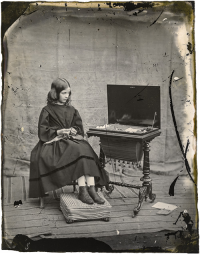Hidden Light- Early Canterbury and West Coast Photography 1850s to late 1890s
 ArtBeat
ArtBeat
Category:
Location:
Category:
Location:

Hidden Light: Early Canterbury and West Coast Photography
Considering how prevalent photography was in Canterbury in the second half of the nineteenth century, it is a wonder the subject has not received more attention. An exhibition which is long overdue, Hidden Light reveals the work of several talented professional and amateur European photographers who practised in Canterbury and the West Coast from the 1850’s onwards.
Most of the photographers included in Hidden Light are relatively unknown and their work has barely been seen. Featuring scenes of colonial life and powerful portrayals of the South Island landscape, Hidden Light taps into aspects of our local history and natural environment while providing some insight into nineteenth-century photographic processes.
Occupying almost one whole wall are eight striking images by Alfred C. Barker, Christchurch’s most prominent nineteenth-century photographer. The digital prints are enlarged reproductions of Barker’s glass-plate collodion negatives and his tender portraits of daughters Mary and Lizzy are particularly beautiful. The picture of Mary dating from 1859 is Pre-Raphaelite-like and reminiscent of the work of Victorian photographer Juliet Margaret Cameron.
Nearby are images by Barker’s contemporaries, Edward P. Sealy and Daniel L. Mundy. Sealy was a surveyor and highly-skilled landscape photographer and his 1869 photograph of Waimakariri Gorge is especially impressive. One of the highlights of the exhibition is Mundy’s remarkable photograph of Benmore Sheep Station from 1868.
Among the photographs of the South Island landscape are Hanwell Williams’ images of Lake Grasmere, Lake Pearson and Lake Lyndon from c.1877 and Thomas Pringle’s views of Franz Josef Glacier from 1871. Capturing the raw beauty of the West Coast, they are rich in detail and command close viewing.
Hidden Light also features a unique selection of cartes-de-visite, little portraits mounted on card. The carte-de-visite became popular in Christchurch after it was introduced in 1862 and due to its shape and format, it was ideal for photo albums. Alongside several portraits of unknown sitters are images of Governor Sir George Grey and Julius von Haast, founder of the Canterbury Museum.
Personal photograph albums previously owned by May Stoddart and Helen Connon are also included in the exhibition. An amateur photographer, Connon was interestingly one of the first New Zealand women to practise photography with a Kodak camera.
Fascinating, impeccably researched and beautifully curated, Hidden Light connects us to our past and is proof that nineteenth-century New Zealand art is still relevant and appealing to contemporary audiences.
Hidden Light: Early Canterbury and West Coast Photography
Curated by Ken Hall
2 February - 25 August
Christchurch Art Gallery Te Puna o Waiwhetū
Cnr Worcester Boulevard and Montreal St, Christchurch
IMAGE